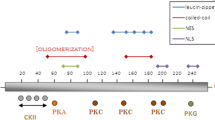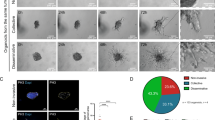Abstract
Introduction of normal, neomycin-tagged human chromosome 11 (neo11) reduces the metastatic capacity of MDA-MB-435 human breast carcinoma cells by 70–90% without affecting tumorigenicity. Differential display comparing MDA-MB-435 and neo11/435 led to the discovery of a human breast carcinoma metastasis suppressor gene, BRMS1, which maps to chromosome 11q13.1–q13.2. Stable transfectants of MDA-MB-435 and MDA-MB-231 breast carcinoma cells with BRMS1 cDNA still form progressively growing, locally invasive tumors when injected in mammary fat pads of athymic mice but exhibit significantly lower metastatic potential (50–90% inhibition) to lungs and regional lymph nodes. To begin elucidating the mechanism(s) of action, we measured the ability of BRMS1 to perturb individual steps of the metastatic cascade modeled in vitro. Consistent differences were not observed for adhesion to extracellular matrix components (laminin, fibronectin, type IV collagen, type I collagen, Matrigel); growth rates in vitro or in vivo; expression of matrix metalloproteinases, heparanase, or invasion. Likewise, BRMS1 expression did not up regulate expression of other metastasis suppressors, such as NM23, Kai1, KiSS1 or E-cadherin. Motility of BRMS1 transfectants was modestly inhibited (30–60%) compared to parental and vector-only transfectants. Ability to grow in soft agar was also decreased in MDA-MB-435 cells by 80–89%, but the decrease for MDA-MB-231 was less (13–15% reduction). Also, transfection and re-expression of BRMS1 restored the ability of human breast carcinoma cells to form functional homotypic gap junctions. Collectively, these data suggest that BRMS1 suppresses metastasis of human breast carcinoma by complex, atypical mechanisms.
Similar content being viewed by others
References
Welch DR, Rinker-Schaeffer CW. What defines a useful marker of metastasis in human cancer? J Natl Cancer Inst 1999; 91 (16): 1351–3.
Welch DR, Wei LL. Genetic and epigenetic regulation of human breast cancer progression and metastasis. Endocrine-related Cancer 1998; 5 (3): 155–97.
Freije JM, MacDonald NJ, Steeg PS. Nm23 and tumour metastasis: basic and translational advances. Biochem Soc Symp 1998; 63: 261–71.
Lee J-H, Miele ME, Hicks DJ et al. KiSS-1, a novel human malignant melanoma metastasis-suppressor gene. J Natl Cancer Inst 1996; 88 (23): 1731–7.
Lee J-H, Welch DR. Suppression of metastasis in human breast carcinoma MDA-MB-435 cells after transfection with the metastasis suppressor gene, KiSS-1. Cancer Res 1997; 57: 2384–7.
Lee J-H, Miele ME, Hicks DJ et al. KiSS-1, a novel human malignant melanoma metastasis-suppressor gene. J Natl Cancer Inst 1997; 89 (20): 1549 [Erratum].
Phillips KK, White AE, Hicks DJ et al. Correlation between reduction of metastasis in the MDA-MB-435 model system and increased expression of the Kai-1 protein. Mol Carcinog 1998; 21 (3): 111–20.
Shindoh M, Higashino F, Kaya M et al. Correlated expression of matrix metalloproteinases and ets family transcription factor E1A-F in invasive oral squamous-cell-carcinoma-derived cell lines. Am J Pathol 1996; 148 (3): 693–700.
Mbalaviele G, Dunstan CR, Sasaki A et al. E-cadherin expression in human breast cancer cells suppresses the development of osteolytic bone metastases in an experimental metastasis model. Cancer Res 1996; 56 (17): 4063–70.
Yoshida BA, Dubauskas Z, Chekmareva MA et al. Identification and characterization of candidate prostate cancer metastasis-suppressor genes encoded on human chromosome 17. Cancer Res 1999; 59 (21): 5483–7.
Zou Z, Anisowicz A, Hendrix MJC et al. Maspin, a serpin with tumorsuppressing activity in human mammary epithelial cells. Science (Washington DC) 1994; 263 (5146): 526–9.
Zhang M, Shi Y, Magit D et al. Reduced mammary tumor progression in WAP-TAg/WAP-maspin bitransgenic mice. Oncogene 2000; 19 (52): 6053–8.
DeClerck YA, Perez N, Shimada H et al. Inhibition of invasion and metastasis in cells transfected with an inhibitor of metalloproteinases. Cancer Res 1992; 52 701–8.
Khokha R. Suppression of the tumorigenic and metastatic abilities of murine B16-F10 melanoma cells in vivo by the overexpression of the tissue inhibitor of metalloproteinases-1. J Natl Cancer Inst 1994; 86 (4): 299–304.
Seraj MJ, Samant RS, Verderame MF et al. Functional evidence for a novel human breast carcinoma metastasis suppressor, BRMS1, encoded at chromosome 11q13. Cancer Res 2000; 60 (11): 2764–9.
Yoshida BA, Sokoloff M, Welch DR et al. Metastasis-suppressor genes: a review and perspective on an emerging field. J Natl Cancer Inst 2000; 92 (21): 1717–30.
Price JE, Polyzos A, Zhang RD et al. Tumorigenicity and metastasis of human breast carcinoma cell lines in nude mice. Cancer Res 1990; 50 (3): 717–21.
Welch DR, Tomasovic SP. Implications of tumor progression on clinical oncology. Clin Exptl Metastasis 1985; 3: 151–88.
Fu TM, Bonneau RH, Epler M et al. Induction and persistence of a cytotoxic T lymphocyte (CTL) response against a herpes simplex virus-specific CTL epitope expressed in a cellular protein. Virology 1996; 222 (1): 269–74.
Kierstead TD, Tevethia MJ. Association of p53 binding and immortalization of primary C57BL/6 mouse embryo fibroblasts by using simian virus 40 T-antigen mutants bearing internal overlapping deletion mutations. J Virol 1993; 67 (4): 1817–29.
Welch DR. Technical considerations for studying cancer metastasis in vivo. Clin Exp Metastasis 1997; 15 (3): 272–306.
Rao VH, Singh RK, Bridge JA et al. Regulation of MMP-9 (92 kDa type IV collagenase/gelatinase B) expression in stromal cells of human giant cell tumor of bone. Clin Exp Metastasis 1997; 15 (4): 400–9.
Martelli AM, Tabellini G, Bortul R et al. Enhanced nuclear diacyl-glycerol kinase activity in response to a mitogenic stimulation of quiescent Swiss 3T3 cells with insulin-like growth factor I. Cancer Res 2000; 60 (4): 815–21.
Flanagan L, Van Weelden K, Ammerman C et al. SUM-159PT cells: a novel estrogen independent human breast cancer model system. Breast Cancer Res Treat 1999; 58 (3): 193–204.
Shafie SM, Formation of metastasis by human breast carcinoma cells (MCF7) in nude mice. Cancer Lett 1980; 11: 81–7.
Soule HD, Maloney TM, Wolman SR et al. Isolation and characterization of a spontaneously immortalized human breast epithelial cell line, MCF-10. Cancer Res 1990; 50 (18): 6075–86.
Pauley RJ, Soule HD, Tait L et al. The MCF10 family of spontaneously immortalized human breast epithelial cell lines: models of neoplastic progression. Eur J Cancer Prev 1993; 2 (Suppl 3): 67–76.
Thompson EW, Sung V, Lavigne M et al. LCC15-MB: a vimentin-positive human breast cancer cell line from a femoral bone metastasis. Clin Exp Metastasis 1999; 17 (3): 193–204.
Wei LL, Yang X, Phillips KK et al. Analysis of KAI-1 mRNA expression in human breast cancer cell lines. Proc Am Assoc Cancer Res 1996; 37 529.
Kurebayashi J, McLeskey SW, Johnson MD et al. Quantitative demonstration of spontaneous metastais by MCF7 human breast cancer cells cotransfected with fibroblast growth factor 4 and LacZ. Cancer Res 1993; 53 (9): 2178–87.
Stracke ML, Krutzsch HC, Unsworth EJ et al. Identification, purification, and partial sequence analysis of autotaxin, a novel motility-stimulating protein. J Biol Chem 1992; 267 (4): 2524–9.
Walther SE, Denhardt DT. Directed mutagenesis reveals that two histidines in tissue inhibitor of metalloproteinase-1 are each essential for the suppression of cell migration, invasion, and tumorigenicity. Cell Growth Differ 1996; 7 (11): 1579–88.
Lester BR, McCarthy JB. Tumor cell adhesion to the extracellular matrix and signal transduction mechanisms implicated in tumor cell motility, invasion and metastasis. Cancer Metastasis Rev 1992; 11 (1): 31–44.
Hernández-Alcoceba R, Del Peso L, Lacal JC. The Ras family of GTPases in cancer cell invasion. Cell Mol Life Sci 2000; 57 (1): 65–76.
Curran S, Murray GI. Matrix metalloproteinases: molecular aspects of their roles in tumour invasion and metastasis. Eur J Cancer [A] 2000; 36 (13): 1621–30.
Koblinski JE, Ahram M, Sloane BF. Unraveling the role of proteases in cancer. Clin Chim Acta 2000; 291 (2): 113–35.
Li L, Price JE, Fan D et al. Correlation of growth capacity of human tumor cells in hard agarose with their in vivo proliferative capacity at specific metastatic sites. J Natl Cancer Inst 1989; 81 (18): 1406–12.
Nicolson GL, Lembo TM, Welch DR. Growth of rat mammary adenocarcinoma cells in semisolid clonogenic medium not correlated with spontaneous metastatic behavior: Heterogeneity in the metastatic, antigenic, enzymatic and drug sensitivity properties of cells from different sized colonies. Cancer Res 1988; 48 (2): 399–404.
Leone A, Flatow U, King CR et al. Reduced tumor incidence, metastatic potential, and cytokine responsiveness of nm23-transfected melanoma cells. Cell 1991; 65 (1): 25–35.
Leone A, Flatow U, VanHoutte K et al. Transfection of human nm23-H1 into the human MDA-MB-435 breast carcinoma cell line: effects on tumor metastatic potential, colonization and enzymatic activity. Oncogene 1993; 8 (9): 2325–33.
Loewenstein WR, Kanno Y. Intercellular communication and the control of tissue growth: Lack of communication between cancer cells. Nature (London) 1966; 209 (29): 1248–9.
Yamasaki H, Mesnil M, Omori Y et al. Intercellular communication and carcinogenesis. Mutation Res Fundam Mol Mech Mutagenesis 1995; 333 (1-2): 181–8.
Ito A, Katoh F, Kataoka TR et al. A role for heterologous gap junctions between melanoma and endothelial cells in metastasis. J Clin Invest 2000; 105 (9): 1189–97.
El-Sabban ME, Pauli BU. Cytoplasmic dye transfer between metastatic tumor cells and vascular endothelium. J Cell Biol 1991; 115 (5): 1375–82.
Nicolson GL, Dulski KM, Trosko JE. Loss of intercellular junction communication correlates with metastatic potential in mammary adenocarcinoma cells. Proc Natl Acad Sci USA 1988; 85 (2): 473–6.
Donahue HJ. Gap junctions and biophysical regulation of bone cell differentiation. Bone 2000; 26 (5): 417–22.
Saunders MM, Seraj MJ, Li ZY et al. Breast cancer metastatic potential correlates with a breakdown in homospecific and heterospecific gap junctional intercellular communication. Cancer Res 2001; 61 (5): 1765–7.
Fidler IJ, Radinsky R. Genetic control of cancer metastasis. J Natl Cancer Inst 1990; 82: 166–8.
Fidler IJ, Radinsky R. Search for genes that suppress cancer metastasis. J Natl Cancer Inst 1996; 88 (23): 1700–3.
Author information
Authors and Affiliations
Rights and permissions
About this article
Cite this article
Samant, R., Seraj, M., Saunders, M. et al. Analysis of mechanisms underlying BRMS1 suppression of metastasis. Clin Exp Metastasis 18, 683–693 (2000). https://doi.org/10.1023/A:1013124725690
Issue Date:
DOI: https://doi.org/10.1023/A:1013124725690




